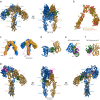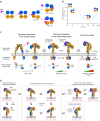A stepwise activation model for the insulin receptor
- PMID: 37779149
- PMCID: PMC10618199
- DOI: 10.1038/s12276-023-01101-1
A stepwise activation model for the insulin receptor
Abstract
The binding of insulin to the insulin receptor (IR) triggers a cascade of receptor conformational changes and autophosphorylation, leading to the activation of metabolic and mitogenic pathways. Recent advances in the structural and functional analyses of IR have revealed the conformations of the extracellular domains of the IR in inactive and fully activated states. However, the early activation mechanisms of this receptor remain poorly understood. The structures of partially activated IR in complex with aptamers provide clues for understanding the initial activation mechanism. In this review, we discuss the structural and functional features of IR complexed with various ligands and propose a model to explain the sequential activation mechanism. Moreover, we discuss the structures of IR complexed with biased agonists that selectively activate metabolic pathways and provide insights into the design of selective agonists and their clinical implications.
© 2023. The Author(s).
Conflict of interest statement
The authors declare no competing interests.
Figures







References
-
- Diagnosis and classification of diabetes mellitus. Diabetes Care37, S81-S90 (2014). - PubMed
Publication types
MeSH terms
Substances
LinkOut - more resources
Full Text Sources

